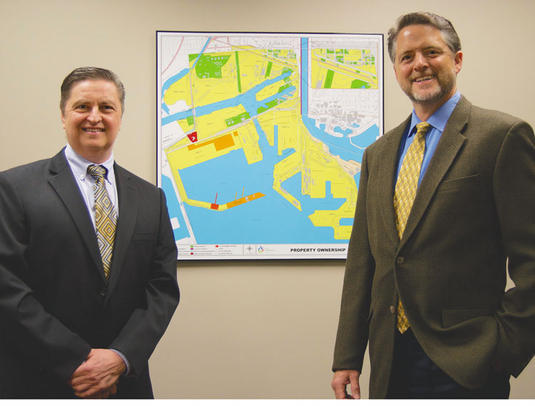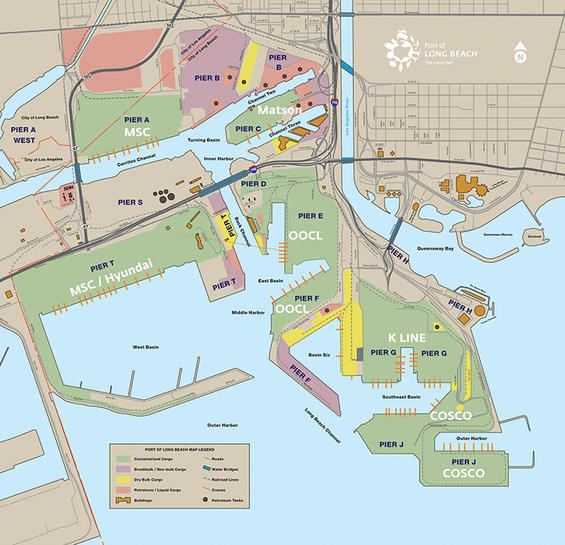Each year, the Port of Long Beach handles more than 6.8 million 20-foot container units, which is more than 82.3 million metric tons of cargo valued at around $180 billion. For fiscal year 2017, the port has a $744 million budget and $373 million in proposed operating revenue.
“Every function in the port certainly is important, but the leases generate 90% of the operating revenue of the port,” Karl Adamowicz, director of real estate at the port, said. “So it’s critical to the health of the port that the leases are good and we generate a significant amount of revenue.”

Karl Adamowicz, left, director of real estate for the Port of Long Beach, said the port has approximately 40 marine terminals. Adamowicz, Eamonn Killeen, right, assistant director of real estate, and their team manage hundreds of leases, permits and agreements on port property. (Photograph by the Business Journal’s Larry Duncan)
There are approximately 40 marine cargo terminals, which make up the bulk of port operations, according to Adamowicz. He said these terminals generate most of the revenue and occupy most of the time of his small team of nine.
The average lease length for marine cargo terminals is between 15 and 25 years. This is to provide stability to both the company and the port, according to Adamowicz. Pursuant to the City Charter, the port renegotiates rates, insurance requirements and environmental conditions every five years with tenants.
There are anomalies in lease terms, as with National Gypsum’s 60-year lease that began in 1964 and Orient Overseas Container Line’s (OOCL) 40-year agreement at the new Middle Harbor. In the case of OOCL, the company is part of the 10-year redevelopment project with an additional 30 years thereafter. Adamowicz explained this agreement occurred because OOCL is investing $700 million to $800 million of equipment in the project and required enough time to advertise and utilize its significant investment.
Eamonn Killeen, the assistant director of real estate for the port, explained there are various types of agreements but that, regardless, the port has a consistent land value and rate of return. Adamowicz explained that tenants do not pay for space as in normal real estate agreements – a set monthly payment per square foot. Revenue generated from agreements is based on the throughput of cargo.
“So the more cargo that comes through, the more revenue we get; the less cargo that comes through, the less revenue we get,” Adamowicz said. “We have a tariff that describes all the rates and rules and regulations of the port. It will have how much wharfage, which is a charge for cargo to come across the wharf from the ship to the land or the land to a ship.”
For every ship that is loaded or unloaded, port staff receives reports and in turn sends out a bill to the company based on the number of containers transported. However, to protect itself from the effects of an economic downturn, which could greatly reduce the amount of cargo coming into port, agreements have a built-in annual minimum.

For example, Adamowicz said the minimum for the six container terminals – which take up 1,339 acres and generate a majority of port revenue – ranges from $160,000 to $270,000 per acre. The smallest container terminal is Pier C, which is between 75 and 80 acres, while the largest is the 380-acre Pier T.
“At the end of one lease year, there will be a reconciliation,” Adamowicz said. “If their throughput revenue exceeds the [minimum], there’s no more to do. If the throughput revenue fell short of the [minimum], we issue what’s called a shortfall invoice to bring them up to that.”
Killeen explained that Toyota has had a 144-acre automobile terminal since 1994. The port also has 44 acres of petroleum liquid bulk terminals, 84 acres of dry bulk terminals and 77 acres of breakbulk and general cargo terminals.
“The way the marine terminals operate, they will typically have an administration building, then they will have a truck or gate monitoring center. They will have a rail ops building and a marine ops building,” Killeen said. “So they’ve got various operations, and they are constantly shifting their people around.”
Lee Peterson, a media relations specialist with the port, explained that the largest building at the port is a three-story office building. He said there will likely never be a larger building, as tenants only want as much space as they need for their purposes. The buildings for each company’s operations are included in their overall lease agreement and require no additional payment based on square footage.
Aside from their larger leases, the real estate team at the port oversees between 75 and 100 ancillary and temporary use agreements. The Alameda Corridor, a 20-mile railroad express line that connects the ports of Long Beach and Los Angeles to the transcontinental railroad, is jointly managed by both harbors and includes up to 400 agreements also overseen by port real estate teams.
The team also handled the acquisition of property for the new Gerald Desmond Bridge. This required vacating current port property and relocating or displacing several tenants that occupied the property, Killeen said.
“We continue to work with private owners and with our existing port boundaries to accommodate the bridge design as it gets tweaked in its final stages,” Killeen explained.
“So for us, it’s been a significant undertaking to be part of that bridge team and acquire all the property rights that we need to,” Adamowicz added.
After the introduction of the Clean Air Action Plan, Adamowicz said there was a learning process for port staff and tenants on how to best implement green port policies. Peterson said in the last 10 years, the port has added environmental requirements to tenant lease agreements. Otherwise, the port would not be able to impose environmental regulations on tenants.
“We’ve been much more engaged with the tenants in trying to negotiate some viable, yet strong enough, conditions that would allow for us to achieve those goals in the Clean Air Action Plan,” Adamowicz said. “It was really unique, so it was quite a challenge. But for the most part, we’ve been successful. Prior to that, it was just about the traditional real estate stuff.”
